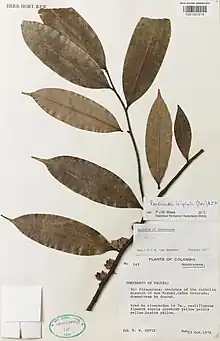| Pseudoxandra leiophylla | |
|---|---|
 | |
| Herbarium specimen of Pseudoxandra leiophylla.[1] | |
| Scientific classification | |
| Kingdom: | Plantae |
| Clade: | Tracheophytes |
| Clade: | Angiosperms |
| Clade: | Magnoliids |
| Order: | Magnoliales |
| Family: | Annonaceae |
| Genus: | Pseudoxandra |
| Species: | P. leiophylla |
| Binomial name | |
| Pseudoxandra leiophylla | |
| Synonyms | |
|
Pseudoxandra coriacea R.E.Fr. Unonopsis leiophylla Diels | |
Pseudoxandra leiophylla is a species of plant in the family Annonaceae. It is native to Brazil, Colombia, and Venezuela.[1] Ludwig Diels, the German botanist who first formally described the species using the basionym Unonopsis leiophylla, named it after its smooth (Latinized form of Greek λεῖος, leîos)[3] leaves.[4]
Description
It is a tree reaching 4 to 25 meters in height. Its shiny leathery leaves are 10-20 by 4-7 centimeters and come to a point at their tips. The leaves are hairless on their upper and lower surfaces, but can have warty bumps. The leaves are dark brown, greenish brown or black-brown above and brown or dark brown on their underside. Its petioles are 2-8 millimeters long. Its flowers are solitary or in pairs and axillary. Each flower is on a pedicel 1-5 millimeters long. Its flowers have 3 oval-shaped sepals that are 2-5 by 4-7 millimeters. The sepals are hairy when young, but smooth when mature. Its 6 petals are arranged in two rows of 3. The outer petals are white, 7-12 by 7-8 millimeters, and concave. The outer petals are densely hairy on their outer surface. The inner petals are white, 5-9 by 4-5 millimeters, and concave. The inner petals are smooth on their outer surface except for a densely hairy patch running from the tip to the base. It has numerous stamens that are 1.5-3 millimeters long. Each flower has 2-15 monocarps that are yellow, brown, red or black at maturity and 9-14 millimeters wide. Its shiny brown seeds are 4-9 by 7-9 millimeters.[5]
Reproductive biology
The pollen of P. leiophylla is shed as permanent tetrads.[6]
References
- 1 2 "Pseudoxandra leiophylla (Diels) R.E.Fr". Plants of the World Online. The Trustees of the Royal Botanic Gardens, Kew. n.d. Retrieved May 22, 2019.
- ↑ Botanic Gardens Conservation International (BGCI).; IUCN SSC Global Tree Specialist Group (2019). "Pseudoxandra leiophylla". IUCN Red List of Threatened Species. 2019: e.T143325615A143325617. doi:10.2305/IUCN.UK.2019-1.RLTS.T143325615A143325617.en. Retrieved 13 November 2021.
- ↑ Stearn, William (2004). Botanical Latin. Portland, Ore. Newton Abbot: Timber Press David & Charles. ISBN 9780881926279.
- ↑ Diels, L. (1931). "Anonaceae novae" [New Anonaceae]. Notizblatt des Königlichen botanischen Gartens und Museums zu Berlin (in Latin and German). 11 (102): 73–86. doi:10.2307/3994585. JSTOR 3994585.
- ↑ Maas, Paul J.M.; Westra, Lubbert Y.Th. (2003). "Revision of the Neotropical genus Pseudoxandra (Annonaceae)". Blumea - Biodiversity, Evolution and Biogeography of Plants. 48 (2): 201–259. doi:10.3767/000651903X674955. ISSN 0006-5196.
- ↑ Walker, James W. (1971). "Pollen Morphology, Phytogeography, and Phylogeny of the Annonaceae". Contributions from the Gray Herbarium of Harvard University. 202 (202): 1–130. JSTOR 41764703.
External links
